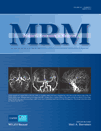On B1 inhomogeneity correction of in vivo human brain glutamate chemical exchange saturation transfer contrast at 7T
Abstract
The effects of radio frequency field (B1) inhomogeneity on measured in vivo human brain glutamate chemical exchange saturation transfer contrast maps are normally confounded with contributions from chemical exchange saturation transfer, direct saturation and magnetization transfer effects. Consequently, the chemical exchange saturation transfer effect variation with B1 follows a complicated function and depends on the tissue types as well. In this work, we developed and tested a novel approach for B1 inhomogeneity correction based on acquiring calibration data at a coarsely sampled B1 values in conjunction with the measured B1 maps. With this approach, different calibration curves are derived for gray matter and white matter instead of a simple linear scaling based on local B1 values. Potential extensions of this approach to study chemical exchange saturation transfer contrast from other metabolites and tissue types are discussed. Magn Reson Med, 2013. © 2012 Wiley Periodicals, Inc.




